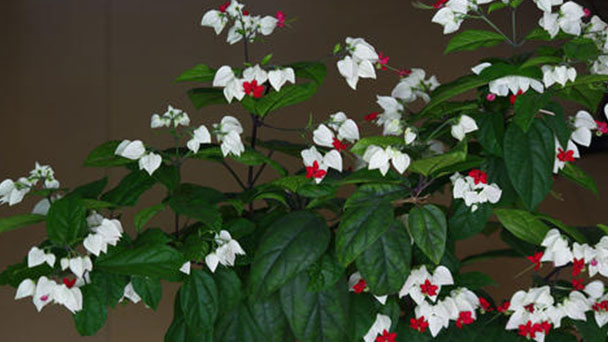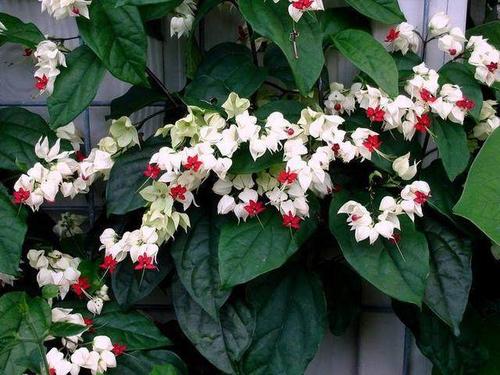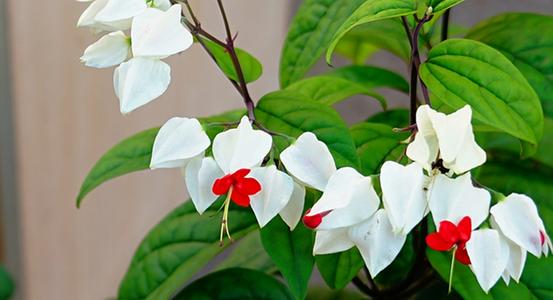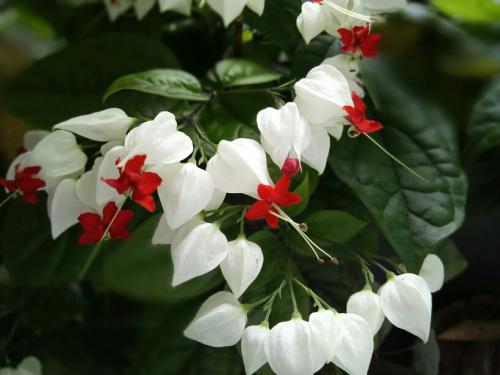Bleeding heart vine profile
Written by Maggie
Aug 24 2021

Bleeding heart vine, Clerodendrum thomsoniae, is a kind of butterfly in the Verbenaceae genus. In summer and autumn, the top white calyx spits out bright red corolla with red and white inlaid, giving the appearance of Bleeding heart vine. It is a common pot flower.
Bleeding heart vine picture

Morphological characteristics of Bleeding heart vine
Bleeding heart vine (Clerodendrum thomsoniae) is a kind of perennial evergreen vine with a height of 2 to 5 meters and a four-edged stem. Leaves are opposite, oblong, 6-10 cm long. The cymose is axillary; Flowers in spring and summer, the flowers are very beautiful, calyx white larger, the upper part of the corolla deep red, when the flowers open red corolla from the white sepals protruding, just like Bleeding heart vine.
Bleeding heart vine (Clerodendrum thomsoniae) is a kind of vine with four edges. Leaves are simple opposite, dark green, ovate-shaped rectangular orbicular or ovate, apex acuminate, base rounded, veins from the base of three, entire, short stipitate. Cymes, terminal or axillary, diffused, bifid branched, calyx tube short, green, lobes white, ovate, persistent, corolla tube cylindrical, weak, 5 lobes dark red, protruding from calyx, stamens and styles very long, protruding outside the corolla, flowering spring and summer.Fruit flesh spherical, blue, larger seeds, long oval, black.
Bleeding heart vine (Clerodendrum thomsoniae) is a climbing shrub with a height of 2-5 m. Young branches have four prismatic, yellow brown short villi, old glabrous, tender branch pitch when loose, hollow after old. Leaf blade is papery, narrowly ovate or ovate-oblong, 4-10 cm long and 1.5-4 cm wide, apically acuminate, base suborbicular, entire, surface covered with verrucola hairs, slightly rough, abaxially sub glabrous, basal veins triplicate; The petiole is 1-2 cm long.Cymes axillary or pseudo-terminal, branched dichasally, 7 -- 15 cm long, 10 -- 17 cm wide; Bracts are narrowly lanceolate, 0.5-1 cm long; The calyx white, base connate, middle expanded, 5-ridged, apical 5-lobed, outer covered with fine hairs, lobes triangular-ovate, 1.5-2 cm long, 1-1.2 cm wide, apical acuminate; Bleeding heart vine corolla us dark red, glandular hairs, lobes elliptic, ca. 9 mm, corolla tubes subequal to calyx; Bleeding heart vine has 4 stamens, extruding from corolla with style;Stigma 2-lobed. Drupe is nearly globose, about 1.4 cm in diameter, there are 2-4 nucleated, exocarp bright, brown black; Persistent calyx is not enlarged, reddish purple.
The flowering period of Bleeding heart vine is from March to May.
Ecological habits of Bleeding heart vine
Bleeding heart vine (Clerodendrum thomsoniae) likes warm, humid and sunny semi-shade environments, not cold. Overwintering temperature should be above 15°C, long-term below 10°C, can cause falling leaves to death. With sowing or cutting method propagation, seed life is short, after harvest sow namely.
The optimum temperature of Bleeding heart vine was 18 ~ 24℃, 18 ~ 30℃ from February to October, and 13 ~ 16℃ from October to the next February. The temperature in winter is not lower than 8℃. The stem and leaves above 5℃ are susceptible to freezing damage. The light ones cause falling leaves, and the heavy ones cause tender stems to wither. The temperature of vegetative growth period can be high, the temperature above 30℃. As long as the water supply is sufficient, it can still grow normally. And reproductive growth, that is, the temperature of the flowering period should be lower, about 17℃.
The soil is a fertile, loose and well-drained sandy loam. A mixture of peat and coarse sand used for potting.
Growing method of Bleeding heart vine
Planting
Clerodendrum thomsoniae can be changed every 1 to 2 years. It can be changed in early spring or after the flower has faded. When replacing the pot, first use the broken tiles to mat the drainage hole, and then put a small amount of bone powder as the base fertilizer, and then load the new culture soil (4 humic soil, 4 garden soil, 2 sand soil), plant the plant, leaving 2~3 cm along the mouth, in order to fertilize and water. Change the pot after pouring permeable, put the shade of slow seedlings, slow seedlings moved to the sunny place after maintenance.

Watering
Bleeding heart vine (Clerodendrum thomsoniae) was sensitive to water. Stem and leaf growth period to keep saline soil moist, but not excessive watering, water is too large, resulting in only long tendrils and not flowering, even leaves yellow, fall, root decay and death. In the summer high temperature season, it should be fully watered, appropriate shade. In winter, reduce watering, make it dormant, in order to ensure safety over the winter.
The two main steps of Bleeding heart vine are watering and pruning. Bleeding heart vine is humid, requiring sufficient water during growth and development. But water is overmuch, basin soil is excessive damp, causing the leaf to turn yellow easily and fall off. During the growth, watering should pay attention to even, basin soil often keeps wet state, and should not be too wet or too dry, should not be wet and dry.
Temperature and Light
Sufficiency of sunlight in winter and shade in hot summer, otherwise the leaves will turn yellow. When the light is insufficient, it can cause vine sex to grow, do not blossom. Flower bud differentiation is not affected by photoperiod, but strong light can promote flower bud differentiation and development. It should not be placed in the dark for too long. At the temperature of 21℃ above, more than 24 hours, it will fall.
After spring weather turns warm, put it in the courtyard or on the balcony of south, spring, autumn gives sufficient illumination. In the summer high temperature, it should be placed in the shade shed or shaded place.
After winter, move it into the room to control watering, stop fertilizing, put in the sun, and keep the room temperature above 12℃ to safely overwinter.
Soil
The soil is rich, loose and well drained sandy loam.
Fertilization
Fertilization should not be too much, the flowering season every 7~10 days to apply 1 times the stale thin cake fertilizer water, even 3~4 times fertilizer can be. If yellowing is found in the process of cultivation, the leaf can be gradually changed from yellow to green by applying top dressing (0.2% ferrous sulfate).
Bleeding heart vine propagation methods
1. Sow propagation
The seeds of Bleeding heart vine are larger than those of Bleeding heart vine. The seeds can be soaked in warm water for 12 hours before sowing, and the seedling can emerge in 10 days at 20-25℃ under the method of on-demand sowing. Transplant once with 3-4 leaves, put 1-3 plants in each pot when the seedling height is 10 cm, and flower in the second year.
Seeding can be sown in shallow pots from March to April each year, the temperature is kept at 24°C, and seedlings can emerge in 10 days. Transplant seedlings in pots when the seedlings are 10 cm high, and they can blossom in the second year. Sowing method is not easy to survive, it is recommended to use cuttage propagation.
2. Cutting propagation
Cuttings are generally carried out in spring and autumn. Cuttings can be inserted into branches, leaf buds and roots. Shoot, can choose strong annual branches cut into 2-3 sections, keep the top leaves and cut off 1/2, insert in plain sand soil, in the shade of maintenance, maintain humidity, can take root in 20 days, 35 days on the pot planting; Leaf bud insertion, take the side bud on the branch as cuttings, cut with a small section of branches, and then cuttings in the substrate, bud exposed outside the substrate, shading curing 20-25 days can take root, to be on the basin after leaf bud germination; Root inserts can be combined to change the basin to carry on, the root shape porcine stem on the soil is cut into 8-10 cm section as cuttings. Matrix should choose peat with good permeability, vermiculite, perlite, leaf rot soil or sand to wait, but with slant acid is better.
Cuttage is generally carried out in May~ June every year, the top of healthy and disease-free branches can be selected, and the lower branches can also be cut into 8 ~ 10 cm stem segments as cuttings. Bud grafting is to take the side bud on the branch, with a part of the xylem, as cuttings. Root inserts are root shaped stolons cut into 8 ~ 10 cm long for cuttings. The cuttings can be used peat, perlite, leaf rot soil, river sand and vermiculite and other substrates, the best spring and autumn cuttings, cuttings suitable temperature is 21℃, and the temperature of the cuttings is 26℃, which is very beneficial to rooting. It takes roots 3 weeks after implantation. If the base of cuttings was treated with 0.5% ~ 0.8% indolebutyric acid solution for 1 ~ 2 seconds, the roots could be more rapid. More about Bleeding Heart Vine Propagation.
Disease control of Bleeding heart vine
Bleeding heart vine (Clerodendrum thomsoniae) is a kind of Bleeding heart vine that causes leaf spot disease. At first just a small brown dot, such as not timely treatment will produce large black spots, leaf withered yellow dye. Therefore, once found sick, we should immediately use chlorothalonil 800 times liquid, foliar spray, once every 7-8 days, 2-3 consecutive times, and it can be basically cured.
The main insect pests are scale insects, white whitefly, etc., and it can be sprayed with 40% oxidized dimethoate 1000 times to 1500 times liquid. Leaves can not stretch normally caused by alkaline soil, leaves lose green and yellow, and it can be irrigated with 0.2% ferrous sulfate solution. For Mosaic disease and mycosis, it is necessary to remove the diseased leaves in time, strengthen ventilation, and keep the leaves dry, which can control the disease.
The main diseases of Bleeding heart vine are foliage shedding fungal disease, common rust, gray mold and Mosaic virus disease. Rust with 20% rust spirit emulsion 400 times the spray, gray mold and Mosaic virus disease with 50% benzodiazepine WP 2500 times the spray control.
Bleeding heart vine (Clerodendrum thomsoniae) can be used to kill 3000 times of 2.5% enemy liquid.

Latest Updated
- Benefits of Bugleweed - 7 Science-backed Health Benefits
- Bugleweed Dangers & Side Effects - Is It Poisonous?
- How to Plant Evergreen Trees - What You Should Know
- When to Plant Evergreens - Grow Guide for Evergreen Trees
- 12 Wonderful Evergreen Shrubs for Your Garden
- 12 Popular Evergreen Plants with Pictures for Beginners
- When And How To Prune A Lilac Bush Like a Pro
- How to Grow & Care for Lilac Vine (Hardenbergia Violacea)
- Japanese Lilac Tree (Syringa Reticulata) Care & Propagation Guide
- Shumard Oak Pros and Cons - What to Know
Popular Articles
- Winter maintenance of Antirrhinum Majus
- How to Grow Terminalia Mantaly Tree
- How to Grow and Care for Crossostephium Chinense
- How to grow Antirrhinum Majus in spring
- Peristeria Elata (Dove Orchid) Profile: Info & Care Guide
- Underwatered Snake Plant (Sansevieria Trifasciata) - Signs And How To Fix
- How to Care for Brazilian Jasmine Plant (Mandevilla Sanderi)
- How to Grow & Care for Graptopetalum Purple Delight in Summer
- Rosa Chinensis (China Rose): Plant Growing & Care Tips
- How to Care for Baby Sun Rose (Aptenia Cordifolia)